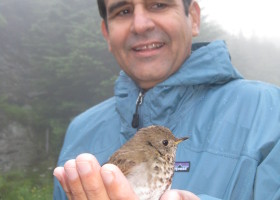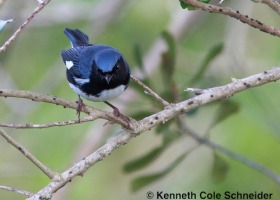 BREEDING SEASON BANDING
BREEDING SEASON BANDING
Located on the ridgeline of Vermont’s highest peak, VCE biologists have been conducting research and monitoring since 1992 that allow us to understand changes—both natural and human-created—to guide conservation action. Our biologists have banded nearly 4,000 birds. Each band is etched with a unique number, like an avian social security number, allowing us to continually track them throughout their lifetime.
The fundamental goal of bird banding has always been to record the age, sex, wing length, and body mass of captured species as a way of monitoring – year to year – how avian populations are faring on the mountain top. But bird banding research has many other uses such as: longevity and survivorship, weight changes, population monitoring, disease and toxins, and more. Ultimately, bird banding helps us understand how to conserve the land and environments in which these birds live and breed.
Our banding records are submitted regularly to the Bird Banding Laboratory, which maintains the bird banding database and permits for the U.S.
 FALL MIGRATION BANDING (1995-1997)
FALL MIGRATION BANDING (1995-1997)
Overall, we captured 3,024 individuals of 62 bird species in 10,048 cumulative net hours (30.1 birds/100 net hr). We divided species into 3 classes: (1) those breeding regularly on Mt. Mansfield above 916 m elevation (16 species), (2) those breeding only sporadically or at very low densities above 916 m (6 species), and (3) those occurring only as transients (40 species). Breeding species accounted for 68% of new captures, followed by transients (22%), and sporadic/low density breeders (10%). Of the ten most abundant species captured, only two, Black-throated Blue Warbler(Setophaga caerulescens) and Ovenbird (Seiurus aurocapillus), were transients, accounting for 50% and 9%, respectively, of all transient captures. Hatching-year birds accounted for 94% of known-age transients and 81% of known-age individuals among locally breeding species. Recapture rates of transients were extremely low (0.3%), while recapture rates among species known to breed locally (including presumed transient individuals) were higher (2.2%). Nearly 75% of all birds captured were very lean at first capture, and only 26% of recaptured individuals increased their fat scores between first and final captures. Weight changes of recaptured birds varied: 48% lost weight, 44% gained weight, and 8% maintained the same weight between first and final captures. Our data suggest that conditions on the Mt. Mansfield ridgeline are not conducive to prolonged migratory stopovers and that most migrants may be unable to meet their energetic requirements for continued migration. However, we believe that montane forest habitats may be preferentially selected by those migrants that use them for breeding. We further believe that montane fir forests may be an important post-fledging dispersal habitat for Black-throated Blue Warblers and other low or mid-elevation breeding species, and that conservation planning for montane forest sites should carefully consider the needs of migrants outside the breeding season.
SCIENTIFIC PUBLICATIONS
Studds, C. E., McFarland, K. P., Aubry, Y., Rimmer, C. C., Hobson, K. A., Marra, P. P. and Wassenaar, L. I. 2012. Stable-hydrogen isotope measures of natal dispersal reflect observed population declines in a threatened migratory songbird. Diversity and Distributions 18: 919–930. (Abstract)
Rimmer, C.C., E.K. Miller, K.P. McFarland, R.J. Taylor, and S.D. Faccio. 2009. Mercury bioaccumulation and trophic transfer in the terrestrial food web of a montane forest. Ecotoxicology 19(4): 697-709. (Abstract)
Frey, S.J.K., C.C. Rimmer, K.P. McFarland, and S. Menu. 2008. Identification and sex determination of Bicknell’s Thrushes using Morphometric Data. J. of Field Ornithology 79: 408-420. (Abstract)
Rimmer, C.C., K. P. McFarland, D. C. Evers, E. K. Miller, Y. Aubry, D. Busby, and R. J. Taylor. 2005. Mercury levels in Bicknell’s thrush and other insectivorous passerine birds in montane forests of the northeastern United States and Canada. Ecotoxicology 14:223-240. (Abstract)
Rimmer, C.C. and K.P. McFarland. 2001. Known breeding and wintering sites of Bicknell’s Thrush. Wilson Bull.113: 234-236. (Abstract)
Hobson, K.A., K.P. McFarland, L.I. Wassenaar, C.C. Rimmer and J.E. Goetz. 2001. Linking breeding and wintering grounds of Bicknell’s Thrushes using stable isotope analyses of feathers. Auk 118:16-23. (Abstract)
Rimmer, C.C. and J.R. Tietz. 2001. An adult male Blackpoll Warbler in female-like plumage. J. Field Ornithol. 72:365-368. (Abstract)
Rimmer, C.C. and K.P. McFarland. 2000. Post breeding dispersal and migration stop-over in a montane spruce-fir forest in northern Vermont. Wilson Bull. 112:124-136. (Abstract)
